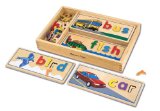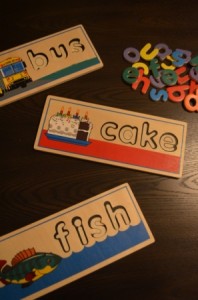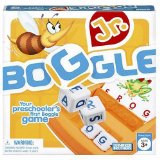Popular Home and Classroom Learning Games for Beginning Readers
Today we look at two popular learning games for beginning readers
I have used both spelling/reading games very successfully with four, five and six-year-olds. Neither is appropriate for younger children due to choking hazard caused by small parts.
We invite you to visit our page about beginning to read.
 Melissa and Doug See and Spell
Melissa and Doug See and Spell
I recently purchased a Melissa and Doug See and Spell puzzle set for my Let’s Read Together program. The set consists of 60 plus colorful wooden letters and eight, two-sided template bases. As shown in my photo (right), the sixteen words include long and short vowels as well as digraphs.
I selected the Melissa and Doug See and Spell puzzle set because it is self correcting and it lends itself well to a group setting. When not being used in the template bases, the letters could be used to spell other words, they could be sorted by attributes or they could be put into alphabetical order.
When one or more children play with See and Spell it is an opportunity to practice letter, object and word recognition, matching, fine motor skills and/or spelling.
Melissa & Doug See & Spell at Amazon.com
Melissa & Doug See & Spell at Amazon.ca
I have used a Boggle Junior game in my Beginning to Read program for more than ten years. It is a great learning game for children who are learning to read and spell. The game consists of a series of illustrated three and four letter words. The words and illustrations are printed on durable cardstock. To play, a child selects a card and spells the word it illustrates using three or four letter cubes. The cubes fit into a sturdy base. The child has the option of seeing how the word is spelled (and simply matching the letters) or attempting to spell the word correctly and then checking to see if he is correct.
Boggle Junior can be enjoyed by one or more children. When one child plays with Boggle Junior it is an opportunity to practice letter, object and word recognition, fine motor skills, matching and/or spelling. When more than one child plays with Boggle Junior, playing the game becomes an opportunity to share and take turns. If two children are at different levels with respect to spelling and reading, one child could match the letters to correctly spell a word, another child could try to spell each word (without matching) and then flip a lever on the base to check the spelling.
The Boggle Junior word cards include short vowels, some long vowels and a few digraphs (i.e. fish).
Boggle Junior Game at Amazon.com
Boggle Junior Game at Amazon.ca











































Carolyn, word and letter games are one of the best ways to get kids decoding, both at the primary and intermediate grades. I found a “Boggle Board” on Pinterest that you make out of poster board. When the kids come in on Monday morning, they make as many words as they can with the board. This way it’s independent and gets them settled. You can do so much from there; have them buddy up and add points like you would in traditional Boggle, have them search for specific vowel sounds, blends, or patterns, have them look for multisyllabic words. A lot of people say, “When I went to school, we just did our work and learned. Our teachers didn’t play games or try to entertain us.” The problem with this, I think, is that these kids are growing up in a faster paced, technological age. Their attention wavers if not captured. Word games are a great way to excite, engage, and (shhh….don’t tell them) LEARN!
I completely agree. One of the children in my Beginning to Read program occupied herself with Boggle Junior last week. She was “pleased as punch” each time she managed to spell a word. I think it is important for parents and teachers to understand that games like these encourage children to be curious about written language and to challenge themselves. Children who play with Boggle Junior are often the ones who (later) choose to try a crossword puzzle or wordsearch. They understand the pleasure in challenging oneself and succeeding.